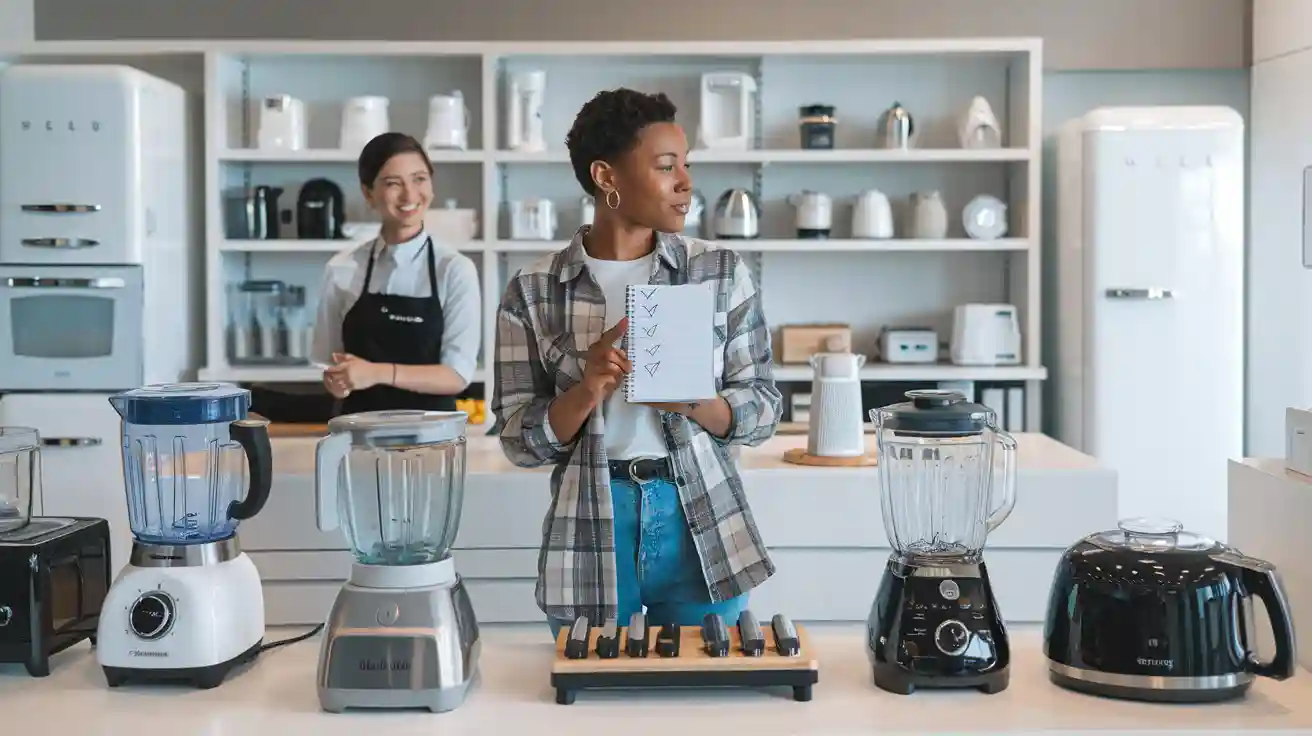
You want the best kitchen appliances, so asking the right questions at kitchen appliance stores near me really helps. When you talk to the appliance store staff, you get answers that match your needs.
- Personalized appliance questions build trust and make you feel confident.
- Quick responses help you decide how to buy appliances with ease.
Check out an appliance buying guide before you visit kitchen appliance stores near me. Good questions make your kitchen shopping experience smoother.
Questions About the Best Appliance for My Budget
How Much Should I Spend at a Kitchen Appliance Store?
When you walk into a kitchen appliance store, it’s easy to feel overwhelmed by all the choices. You want the best appliance for my budget, but prices can range from super affordable to high-end. Take a look at this table to see what you might expect:
| Retailer | Appliance Type | Price Range / Offer Details |
|---|---|---|
| Best Buy | High-end appliance packages (Thermador, Fisher & Paykel, Dacor, Bosch, Samsung, LG, Unique) | Starting under $10,000; various rebates and savings up to $4,000 |
| IKEA | Individual appliances (dishwashers, refrigerators, ovens, cooktops) | From $59.99 (portable induction cooktop) to $2,099 (induction cooktop with downdraft vent); refrigerators and dishwashers between $599 and $1,999 |
You can find appliances for almost any budget. Some people save up for a big package, while others pick one item at a time. Stores often offer payment plans, like 12-month or 48-month options, which help spread out the cost. If you’re budget-conscious, ask about 0% APR deals and make sure you can pay off the balance before interest kicks in. Saving up or shopping during sales can also help you buy an appliance without breaking the bank. Always ask appliance questions about financing and compare options to find the best appliance for my budget.
Are There Any Hidden Costs When Buying Kitchen Appliances?
Buying a new appliance isn’t just about the sticker price. You might face extra costs that sneak up on you. Here are some common hidden fees:
- Delivery charges, especially for stairs or special handling
- Installation fees, which can be high for complex appliances
- Removal fees for your old appliances
- Extended warranties
- After-sales service and maintenance
- Higher energy bills over time
Check out this chart to see how installation costs can add up:
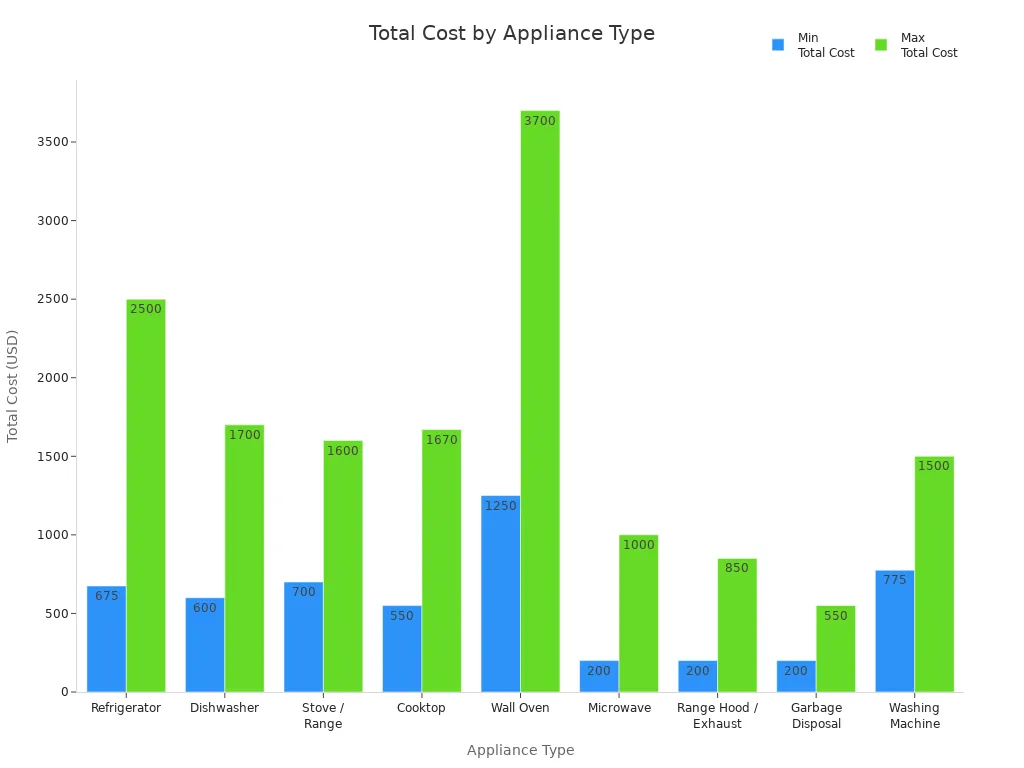
Delivery and installation can add $75 to $500 or more per appliance. Extended warranties usually cost $100 to $300. Always ask questions about these extra costs before you buy an appliance. This way, you can stick to your budget and avoid surprises when buying kitchen appliances.
Questions About Space and Fit for Kitchen Appliances
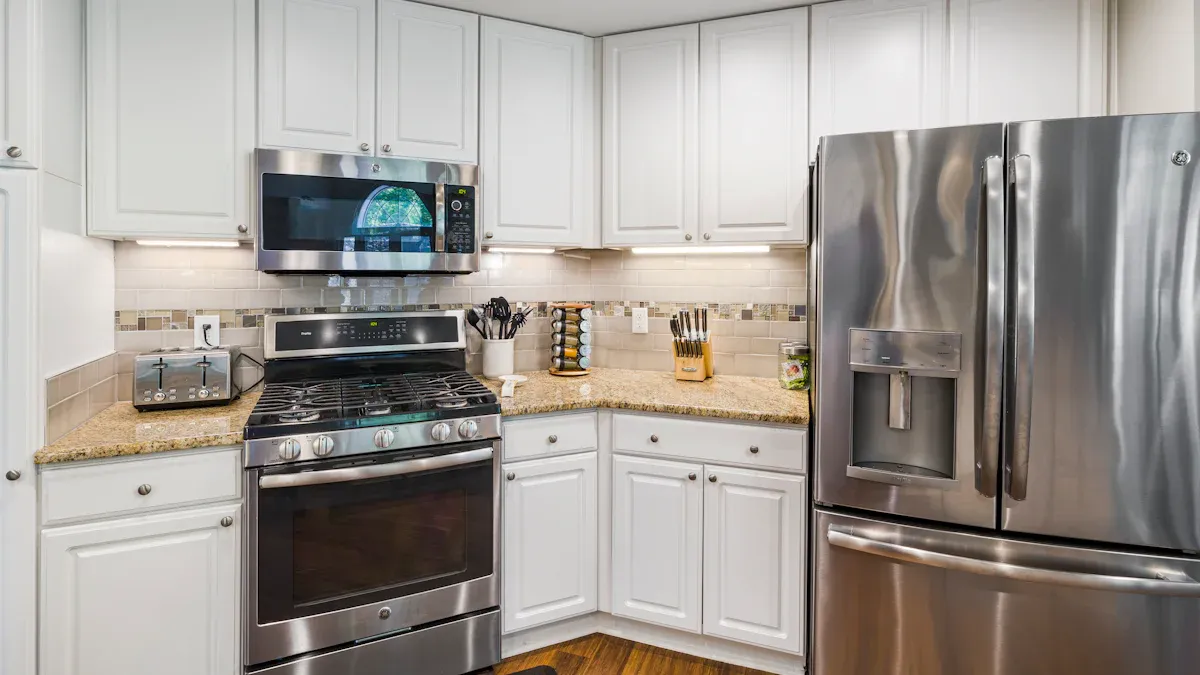
What Are the Exact Measurements Needed?
You want your new kitchen appliances to fit perfectly, so measuring your room is the first step. Grab a tape measure and follow these steps:
- Measure wall widths at the base, middle, and ceiling. Walls can be uneven, so check all spots.
- Measure wall heights at corners and in the middle. This helps you know how much room you have for tall appliances.
- Check doorways and windows, including trim. You need enough room to move appliances in and out.
- Mark where pipes, switches, vents, and outlets are. These spots affect where you can place appliances.
- Draw a simple sketch of your kitchen. Note all measurements and appliance locations.
When you shop for a refrigerator, ranges, or dishwashers, look at the width, height, and depth. Always leave at least one inch of room around each appliance for ventilation and door swings. If you want to maximize usable storage capacity, make sure you measure twice. You can adjust measurements for smaller kitchens or special layouts.
Will the Appliance Fit My Kitchen and Allow for Delivery?
You might wonder, “How much room do I need for delivery and installation?” Here are some tips:
- Walkways should be at least 36 inches wide. This gives you room to move and keeps your kitchen safe.
- Leave 42-48 inches of space around kitchen islands. You need room for doors to open and for people to walk.
- Check the work triangle—the space between your sink, stove, and refrigerator. The total distance should be between 9 and 21 feet.
- Make sure delivery paths, like hallways and doorways, are wide enough for appliances to pass through.
- Allow extra room for ventilation, door swings, and connections.
If you have questions about capacity or fit, ask the store staff. They can help you find kitchen appliances that match your room and needs.
Questions About Features and Daily Use
Which Features Match My Cooking Style and Needs?
When you shop for kitchen appliances, you want features that make life easier. Think about how you cook every day. Do you love baking, or do you want fast meals? Maybe you want a range with air-fry or steam options. Many home cooks now look for new appliance features that save time and boost performance. Here are some of the most popular features people ask about:
- Versatile cooking modes like convection, air-fry, microwave, and sous vide
- Programmable settings for stress-free meal prep
- Smart connectivity for remote control and monitoring
- Easy-clean surfaces and removable trays
- Safety features such as automatic shutoff
- Precision tools like meat probes for perfect results
- Induction cooking for fast, safe, and even heating
- Custom colors and finishes to match your kitchen
If you want to buy induction, you get precise temperature control and energy savings. Induction cooktops also help keep your kitchen cool and safe. Always ask questions about capacity, especially if you cook for a big family or love to host.
Are There Smart or Energy-Saving Kitchen Appliances?
You can find many smart and energy-efficient appliances at local stores. These appliances help you save money and make cooking fun. For example, a smart refrigerator can track your groceries and suggest recipes. Induction cooktops use less energy than gas or electric, so you save on bills. If you want to buy induction, you also get a safer and cleaner kitchen.
Check out this table to see some of the latest advancements:
| Appliance Category | Key Advancements & Features | Energy & Efficiency Benefits |
|---|---|---|
| Smart Refrigerators | AI-powered inventory, smart diagnostics, precise temperature control | Up to 10% energy savings, fresher food, fewer breakdowns |
| Cooking Appliances | Induction cooktops, convection ovens, remote control, AI temperature | Induction saves up to 74% energy, ovens up to 20% more efficient |
| Dishwashers | Smart sensors, eco-modes, water-saving tech | Up to 24% electricity savings, 30% less water used |
| Ventilation Systems | AI controls, air quality monitoring, energy-optimized lighting | Fan energy cut by up to 78%, better air and savings |
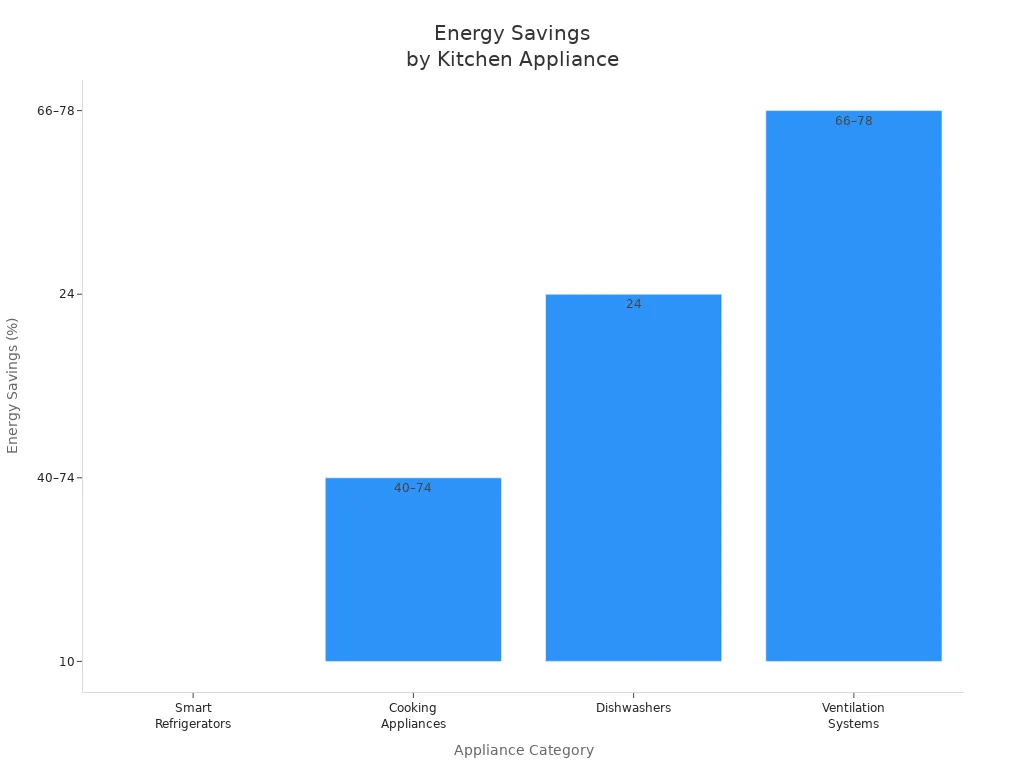
If you care about sustainability, look for energy-efficient appliances. You may even get rebates or tax credits. Always check the capacity of each appliance to make sure it fits your needs and space. Smart technology and induction options can make your kitchen more modern and efficient.
Questions About Finish, Style, and Kitchen Decor
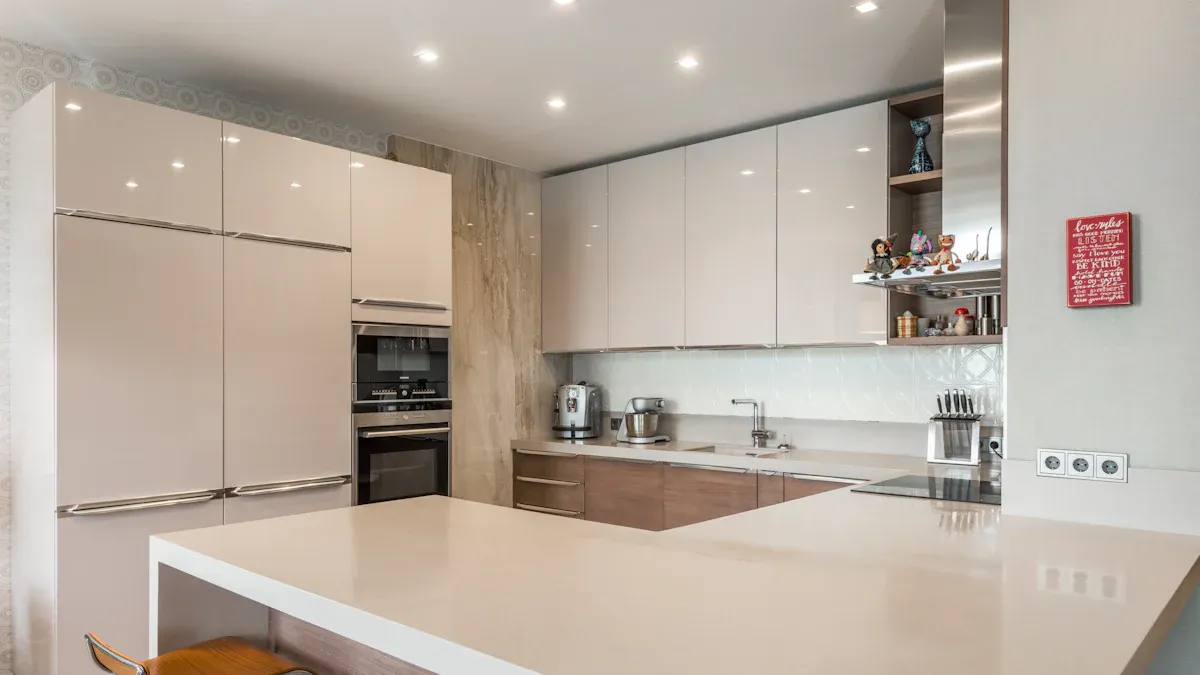
Will the Appliance Match My Kitchen’s Look?
You want your appliances to look great in your kitchen. When you walk into a store, you see many colors and finishes. Some people like bold jewel tones, while others prefer soft matte finishes. You might notice more kitchens with deep blues, greens, or even cherry red appliances. Design experts say people now choose black, beige, or cream instead of just stainless steel. These colors blend well with different styles and make your room feel unique.
Here’s a quick table to help you compare popular finish and style options:
| Finish/Style Category | Popular Colors/Hues | Key Characteristics/Brands |
|---|---|---|
| Bold Jewel Tones | Deep blues, greens, reds | Statement-making designs; Smeg, Bertazzoni, KitchenAid |
| Matte Finishes | Matte black, matte white | Modern appeal; Café, Samsung, GE Profile |
| Retro/Vintage Colors | Pastel blue, cherry red, mint | Vintage-inspired; Smeg, Bertazzoni |
| Earthy Tones | Terracotta, olive, warm browns | Biophilic trends |
| Neutral Alternatives | Black, beige, cream | Blend with many kitchens |
If you want your appliances to stand out or blend in, ask questions about finish choices. You can pick a style that matches your room and shows your personality.
Are There Easy-Clean or Fingerprint-Resistant Options?
You probably want appliances that stay clean with less effort. Fingerprint-resistant finishes help keep surfaces free from smudges and marks. These coatings are tough and protect against rust. You can wipe them with a soft cloth or mild soap. Black stainless steel looks modern and hides fingerprints, but scratches may show more easily.
Here are some tips for easy-clean finishes:
- Matte and fingerprint-resistant coatings hide fingerprints and smudges.
- Stainless steel wipes clean but needs frequent care.
- Matte finishes hide drips but may hide grease if not cleaned often.
- White appliances show stains and scuffs more.
If you have a busy room, easy-clean appliances save you time. You spend less time cleaning and more time enjoying your kitchen.
Questions About Energy Efficiency and Utility Requirements
What’s the Energy Rating and Expected Costs?
When you shop for kitchen appliances, you want to know how much energy they use and how much money you can save. Most major stores sell appliances with Energy Star certification. This label means the appliance uses less energy than standard models. For example, Energy Star refrigerators can save you up to 50% on energy compared to older models. You might pay about $800 for a new fridge, but you could save around $45 each year on your electricity bill. Over 13 years, that adds up!
Here’s a quick look at how different appliances compare:
| Appliance Category | Typical Energy Rating / Efficiency Indicator | Energy Savings Compared to Standard Models | Additional Notes |
|---|---|---|---|
| Refrigerators | Energy Star certified models use ~35% less energy than old models | Up to 35% energy savings | Top-freezer and bottom-freezer models more efficient than side-by-side or French-door; models with ice/water dispensers use more energy |
| Dishwashers | Energy Star models use about half the water and energy compared to 20 years ago | Approx. $50/year operating cost; saves ~5,800 gallons water over lifetime | Use 3-5 gallons water per load; top-rated models also excel in washing/drying performance |
| Ranges (Stovetops) | Induction ranges use about 15% less power than electric coil ranges | 15% energy savings | Induction heats water faster; oven efficiency similar to electric coil or smoothtop ranges |
If you want to buy induction, you get faster cooking and lower energy bills. Energy-efficient appliances help you save money and protect the environment.
Are My Kitchen’s Utilities Compatible with the Appliance?
Before you buy new appliances, check your kitchen’s utility setup. Each appliance needs the right circuit and voltage. For example, a refrigerator usually needs a 20-amp circuit and 120 volts. An electric range often requires a 50-amp circuit and 240 volts. Induction ranges also need a dedicated circuit. Dishwashers and garbage disposals need their own circuits too.

Use this table to double-check your kitchen’s requirements:
| Appliance | Circuit Amperage | Voltage Range | Additional Notes |
|---|---|---|---|
| Refrigerator | 20 amps | 120-125 volts | Dedicated circuit; AFCI protection usually required |
| Electric Range | 50 amps (typical) | 240-250 volts | Dedicated circuit; some ranges may require 30-60 amps |
| Gas Range | N/A | 120-125 volts | Only needs power for controls and vent hood |
| Dishwasher | N/A | N/A | Requires dedicated circuit |
| Small Appliances | N/A | N/A | Use small appliance circuits and lighting circuits |
If you’re not sure, ask the store staff or a licensed electrician. You want your new energy-efficient appliances to work safely and smoothly.
Questions About Delivery and Installation from Appliance Stores
Is Delivery Included or Extra?
When you shop at kitchen appliance stores near me, you might wonder if delivery comes free or if you need to pay extra. Most stores charge a delivery fee for large appliances. For example, Best Buy usually charges about $29.99 to deliver major kitchen appliances if you spend $399 or more. If your purchase is under $399, the delivery fee jumps to $99.99. Sometimes, this lower fee gets included when you also buy professional installation. If you live outside a big city, you might see extra charges for delivery. Always ask your appliance store about their delivery policy before you buy. This way, you avoid surprises and can plan your budget better.
Tip: Ask if the store offers free delivery during special sales or with certain brands. You might save money if you time your purchase right!
Do Appliance Stores Offer Professional Installation?
Many kitchen appliance stores near me offer professional installation services. This can make your life easier, especially if you want your new appliances set up safely and correctly. When you let the pros handle installation, you avoid common problems like:
- Picking the wrong size or type of appliance for your space
- Not reading instructions and setting up appliances the wrong way
- Causing leaks by connecting gas or water lines incorrectly
- Placing hoods too high, so they do not work well
- Not leveling appliances, which can cause doors not to seal or food to cook unevenly
- Damaging your floors or walls during delivery
- Skipping the final test, so leaks or noises go unnoticed
If you want peace of mind, ask your appliance store about their installation options. Some stores bundle installation with delivery, while others charge extra. Always check if the installers are certified and if their work keeps your warranty valid.
Questions About Warranty and Return Policy
How Long Is the Warranty on Kitchen Appliances?
When you buy new appliances, you want to know how long the warranty lasts. Most kitchen appliances come with a manufacturer warranty that ranges from 1 to 5 years. The length depends on the brand, type, and model. Coverage usually starts on the day you buy or install the appliance. Some parts, like refrigerator compressors, may have longer protection than other components.
Here’s a quick look at typical warranty periods:
| Appliance Type | Warranty Duration |
|---|---|
| General Whirlpool Appliances | 1 year limited warranty (parts and labor) |
| Refrigerator Components | 1 year full warranty; compressor and sealed parts 2-5 years |
| Washers and Dryers | 1 year warranty (may vary by model) |
| Dishwashers | 1 year warranty; filters covered starting second year |
| Ranges, Ovens, Cooktops, Microwaves | 1 year warranty (parts and labor) |
You can buy extended warranties if you want extra peace of mind. Make sure you register your appliances to activate the warranty. Most warranties cover defects in materials and workmanship, but they do not cover damage from misuse or unauthorized repairs.
What’s Covered and What’s Not in the Return Policy?
Return policies can be tricky, so you should always ask about the details before you buy appliances. Stores usually allow returns within 7 to 30 days, but you must follow their rules closely. If you want to return an appliance, it should be unused, unopened, and in its original packaging with all accessories.
Here are some common exclusions you might see:
- Custom or clearance appliances are often non-returnable.
- Opened or used appliances can only be returned if they are defective.
- Restocking fees, usually between 10% and 25%, may apply if you return an item for reasons other than defects.
- You may need to pay for return shipping unless the appliance is defective or shipped incorrectly.
- Damage from misuse, improper installation, or unauthorized repairs is not covered.
Tip: Always check if your appliance qualifies for a return before you leave the store. Ask about any fees or special conditions.
Questions About Customer Reviews and Store Reputation
Are There Reviews or Testimonials for This Appliance Store?
You want to feel confident before you buy appliances. One smart move is to read the reviews for any appliance store you visit. Reviews help you see what other shoppers think about the store’s service, product quality, and prices. Many people share their experiences online, so you can spot patterns and avoid surprises.
Check out this table to see how customers rate different retailers:
| Retailer Category | Number of Retailers Rated | Favorably Rated | Unfavorably Rated | Notes on Bargaining Success |
|---|---|---|---|---|
| Large Appliance Retailers | 23 | 17 | 0 | 21% tried to haggle; 67% got a deal; median savings $123 |
| Small Appliance Retailers | 19 | 8 | 2 | 3% tried to haggle; 76% got a deal; median savings $56 |
Most large appliance stores get good reviews. You might even save money if you ask for a better price. Always check for testimonials and ratings before you shop at kitchen appliance stores near me.
How Does the Store Handle Complaints or Issues?
You want to know how an appliance store deals with problems. Stores get complaints about appliances, so you should see how they respond. Common issues include poor build quality, frequent breakdowns, and bad customer service. Some brands, like Samsung and LG, often get reviews about short lifespans or fragile parts. JennAir dishwashers and microwaves may have noisy operation or leaks. KitchenAid, LG, and Samsung refrigerators sometimes get complaints about water leaks or ice maker problems.
Here are the most frequent complaints you’ll find in reviews:
- Poor build quality
- Frequent breakdowns
- Malfunctioning components
- Unhelpful customer service
Tip: Ask the store staff how they handle returns, repairs, and warranty claims. You want a store that listens and solves problems quickly.
If you read the reviews and see how the store handles complaints, you can shop with more confidence. Good stores care about your experience and help you if something goes wrong with your appliances.
Questions About Old Appliance Removal and Disposal
Do Appliance Stores Offer Haul-Away Services?
You probably wonder what to do with your old fridge or stove when you buy a new one. Most kitchen appliance stores make it easy for you. They offer haul-away services, so you do not have to worry about moving heavy appliances yourself. When you schedule delivery for your new appliance, you can often ask the store to take away your old one at the same time. This service saves you time and keeps your home clutter-free.
Here are some things you should check before you buy:
- Ask if the haul-away service is available in your area.
- Find out if the store removes all types of appliances, like refrigerators, ovens, or dishwashers.
- Make sure your old appliance is disconnected and empty before pickup.
Tip: Some stores only offer haul-away if you buy installation or delivery. Always double-check the details with the sales staff.
Is There a Fee for Appliance Disposal?
Most stores charge a small fee to remove your old appliance. The cost depends on the retailer and if you bundle the service with a new purchase. Here’s a quick look at what you might pay:
| Retailer | Appliance Disposal Fee (with new purchase) | Standalone Pickup Fee |
|---|---|---|
| Best Buy | Approximately $30 | $99.99 |
| Lowe’s | $30 (included with installation) | N/A |
| The Home Depot | $25 | N/A |
| Sears | $10 | N/A |
You usually pay between $10 and $30 for disposal when you buy a new appliance. If you want the store to pick up an old appliance without a new purchase, the fee can be much higher.
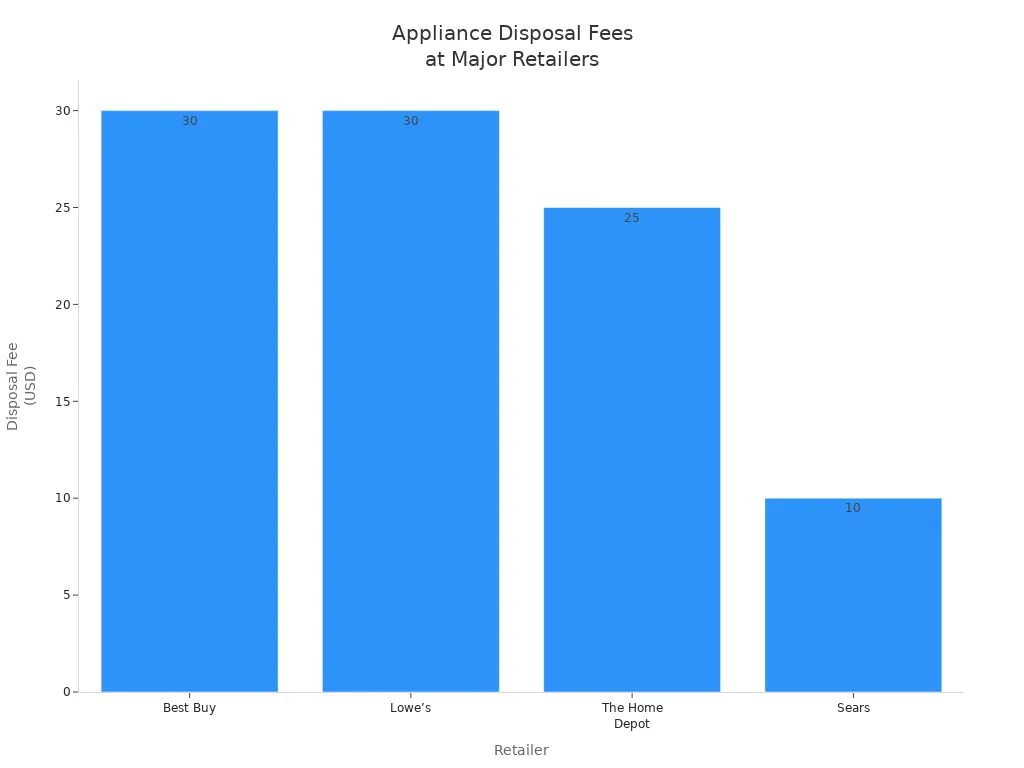
Always ask about these fees before you check out. This way, you avoid surprises and plan your budget better.
Questions About Ongoing Support and Service
Is In-Store Service or Repair Available?
When you buy a new kitchen appliance, you want to know where to go if something goes wrong. Many stores offer in-store service or repair for the brands they sell. You can bring your appliance to the store, and a technician will check it out. Some stores even have repair experts on-site who can fix small problems right away. If your appliance needs a bigger repair, the store might send it to a service center or arrange for a technician to visit your home.
You should always ask the staff about their repair process. Some stores only handle certain brands or types of appliances. Others may offer a loaner if your appliance needs to stay for repairs. This can help you keep your kitchen running smoothly.
Tip: Ask if the store provides free estimates or if there is a fee for checking your appliance.
Who Do I Contact for Help After Buying Kitchen Appliances?
After you bring your new appliance home, you might have questions or need help. Most kitchen appliance stores make it easy for you to get support. You can find downloadable manuals, FAQs, and troubleshooting guides on the brand’s website. These resources answer common questions about installation and daily use.
Many stores also offer live chat features. You can talk to a representative online and get quick answers. Some retailers use AI-powered chatbots that help you 24/7. If your question is more complex, the chatbot will connect you to a real person.
You can also reach out by email. This lets you explain your problem and get detailed help. Email support is great if you need to send photos or documents. With these options, you always have a way to get help and keep your kitchen running smoothly.
Use these questions to shop smarter at kitchen appliance stores near you.
- Ask about delivery, costs, and warranties.
- Get advice on brands and matching appliances.
- Check for rebates and upcoming sales.
When you compare answers from different stores, you spot better deals and avoid common problems. Reach out for tips—salespeople welcome your questions!
FAQ
What should I bring when I visit a kitchen appliance store?
Bring your kitchen measurements, a list of must-have features, and photos of your space. This helps you find the right appliance faster.
Can I negotiate prices at kitchen appliance stores?
Yes, you can! Many stores let you ask for discounts or price matches. Always check for sales or special offers before you buy.
How do I know if an appliance will fit through my door?
Measure your doorways and hallways before you shop. Share these numbers with the store staff. They can help you pick an appliance that fits.


